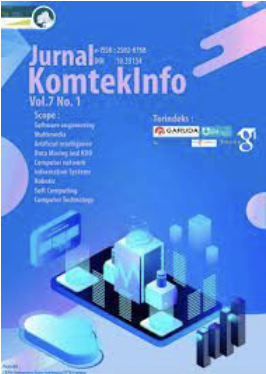Application of Forward Chaining and Certainty Factor Methods to Identify Anxiety Disorder Categories
DOI:
https://doi.org/10.35134/komtekinfo.v12i3.663Keywords:
anxiety disorders, certainty factor, forward chaining, artificial intelligence, expert systemsAbstract
Anxiety disorders are a form of mental disorders that often occur and have a significant impact on the quality of life of individuals. However, the process of diagnosing this disorder still faces various challenges, especially limited access to professionals and difficulties in identifying the type of disorder based on varying symptoms. This research aims to design and implement an expert-based system to help the early diagnosis process of anxiety disorders quickly and accurately. The system was developed as a web application that allows users to answer a series of questions related to the symptoms experienced, then provide possible types of disorders based on the calculation of confidence levels. The method used is forward chaining as an inference engine to conduct a rule and certainty factor search to calculate the level of confidence in the identification results of the symptoms experienced by the user. Data collected from the literature and interviews with experts were built into a knowledge base consisting of 8 types of anxiety disorders with a total of 41 symptoms. Each rule in the system is formulated using an if-then structure that combines CF values to represent the level of confidence in the symptoms and the results of logical inference with advanced tracking methods. The system was tested using 20 test data in the form of symptom-based case simulations. The results of the evaluation showed that the system was able to produce an initial diagnosis with an accuracy rate of up to 100% based on comparison with manual diagnosis from experts. This system also provides explanatory information in the form of confidence level in each diagnosis result. These findings suggest that the Certainty Factor and Forward Chaining approaches are effective in building expert systems for diagnosing anxiety disorders and have the potential to be further developed as a screening tool in educational or primary health care settings.
References
N. Sholihat, “Tata Laksana Gangguan Kecemasan Individu: Perspektif Biopsikologi,” Bookchapter Jiwa, vol. 2, hal. 1–14, 2025.
A. Priambodo, N. Indriarsa, S. Wibowo, V. C. Dinata, dan M. Ridwan, “Peningkatan Kesehatan Mental Remaja Melalui Fun Games dan Deteksi Dini Gangguan Kejiwaan,” J. Pengabdi. Olahraga Masy., vol. 5, no. 2, hal. 94–105, 2024, doi: 10.26877/jpom.v2i2.9971.
R. W. Ainanda, “Hubungan Tingkat Kecemasan Dan Kualitas Hidup Tenaga Kesehatan di Instalasi Gawat Darurat RSUD Dokter Agoesdjam Ketapang Masa Pandemi Covid-19,” Innov. J. Soc. Sci. Res., vol. 5, hal. 6069–6085, 2025.
Y. Firmansyah dan I. Haryanto, “Dua Sisi Gelap Covid-19 : Dilematis Antara Keterbukaan Data Identitas Penderita Covid-19 Dan Transparansi Data Publik Dalam Rangka Menekan Stigmatisasi,” Metta J. Ilmu Multidisiplin, vol. 1, no. 2, hal. 73–85, 2021, doi: 10.37329/metta.v1i2.1349.
V. D. Saputri, “Desain dan Implementasi Sistem Pakar Diagnosa Penyakit Menggunakan Forward Chaining,” J. Komput., vol. 2, no. 2, hal. 75–80, 2024, doi: 10.70963/jk.v2i2.109.
N. Ramadhina, F. Jason, M. F. Pratama, L. A. Raihan, S. Al Mufti, dan M. Meranti, “Dinamika Perubahan dalam Komunikasi Manusia di Era Teknologi Artificial Intelligence,” Commun. Sph., vol. 3, no. 2, hal. 114–123, 2023, doi: 10.55397/cps.v3i2.57.
Ridwan dan B. Hendrik, “Review Metode Sistem Pendukung Keputusan ( SPK ) Terbaik untuk Seleksi Proposal Penelitian : Evaluasi Berdasarkan Kriteria Efektivitas dan Akurasi,” J. Educ. Res., vol. 0738, no. 4, hal. 6456–6462, 2024.
Zen Munawar, Sri Sutjiningtyas, Novianti Indah Putri, Rita Komalasari, dan Herru Soerjono, “Manfaat Kecerdasan Buatan pada Proses Belajar Mengajar di Pendidikan Tinggi,” Tematik, vol. 11, no. 2, hal. 213–224, 2024, doi: 10.38204/tematik.v11i2.2165.
A. Zein, “96-Article Text-177-2-10-20220103.pdf.”
M. Atika dan R. Sayekti, “Studi Literatur Review Sistem Informasi Perpustakaan Berbasis Artificial Intelligence (AI),” N. J. Ilmu Inf. dan Perpust., vol. 14, no. 1, hal. 39–52, 2023, doi: 10.20473/pjil.v14i1.46405.
E. G. Hutahaean, O. S. Pratiwi, dan R. Afriyani, “Penerapan Metode Forward Chaining Dalam Sistem Pakar Diagnosa Penyakit Asma Menggunakan Bahasa Pemrograman Php Dan Database Mysql,” Pros. Semin. Nas. Bisnis, Teknol. Dan Kesehat., vol. 1, no. 1, hal. 96–104, 2024.
G. Gustin dan H. Marcos, “Sistem Pakar Diagnosis Penyakit Lambung Berdasarkan Gejala dan Citra Endoskopi Menggunakan Metode Forward Chaining dan CNN,” J. Tekno Kompak, vol. 18, no. 2, hal. 392, 2024, doi: 10.33365/jtk.v18i1.3944.
S. Maryana dan D. Suhartini, “Implementasi Certainty Factor Untuk Diagnosa Penyakit Sapi,” Chain J. Comput. Technol. Comput. Eng. Informatics, vol. 1, no. 1, hal. 14–20, 2023, doi: 10.58602/chain.v1i1.5.
J. T. Terapan, “SISTEM PAKAR DIAGNOSA PENYAKIT FEBRILE SEIZURES MENGGUNAKAN METODE FORWARD CHAINING DAN TEOREMA BAYES BERBASIS WEB,” J. Teknol. Terap. Sains 4.0, vol. 6, no. 1, 2025.
M. Siddik Hasibuan dan D. Wahyu Habibi Hutabarat, “Sistem Pakar Diagnosis Awal Penyakit Faringitis Dan Laringitis Menggunakan Metode Forward Chaining Dan Certainty Factor,” J. Sci. Soc. Res., vol. 4307, no. 3, hal. 1137–1146, 2024, [Daring]. Tersedia pada: http://jurnal.goretanpena.com/index.php/JSSR
Hafizhah Mardivta, “Penerapan metode forward chaining dan certainty factor untuk mengetahui gangguan mental pada remaja,” J. CoSciTech (Computer Sci. Inf. Technol., vol. 5, no. 1, hal. 215–224, 2024, doi: 10.37859/coscitech.v5i1.6716.
H. Suhendi dan A. Supriadi, “Sistem Pakar Diagnosa Gangguan Kecemasan Menggunakan Metode Certainty Factor Berbasis Website,” Naratif J. Nas. Riset, Apl. dan Tek. Inform., vol. 2, no. 2, hal. 13–23, 2020, doi: 10.53580/naratif.v2i2.94.
C. Oktavia, A. Voutama, dan B. A. Dermawan, “Sistem Pakar Diagnosis Hama Dan Penyakit Tanaman Stroberi Dengan Metode Certainty Factor Berbasis Web,” J. Ilm. Wahana Pendidik., vol. 8, no. 15, hal. 117–127, 2022, [Daring]. Tersedia pada: https://doi.org/10.5281/zenodo.7040696
S. A. S. Mola, A. E. Y. Saragih, dan A. Y. Mauko, “Implementasi Sistem Pakar Penyakit Mata Katarak Menggunakan Metode Certainty Factor,” JIKO (Jurnal Inform. dan Komputer), vol. 8, no. 2, hal. 301, 2024, doi: 10.26798/jiko.v8i2.1129.
G. Zahra, N. Fadhilah, R. A. Saputra, dan A. H. Wibowo, “Deteksi Tingkat Gangguan Kecemasan Menggunakan Metode Random Forest,” J. Fak. Tek. UMT, vol. 13, no. 1, hal. 38–47, 2024, [Daring]. Tersedia pada: http://jurnal.umt.ac.id/index.php/jt/index
Downloads
Published
How to Cite
Issue
Section
License
Copyright (c) 2025 Jurnal KomtekInfo

This work is licensed under a Creative Commons Attribution 4.0 International License.








